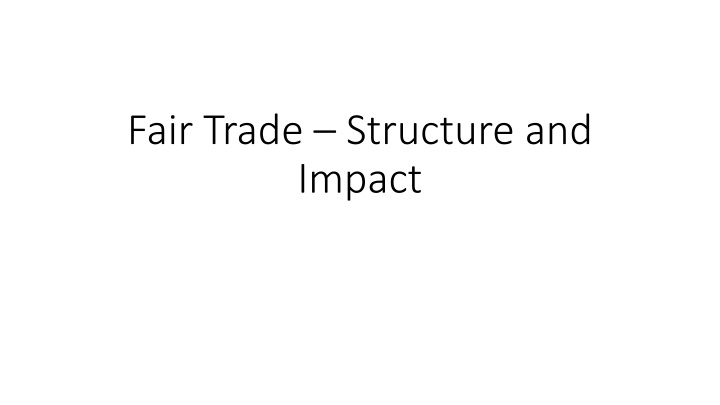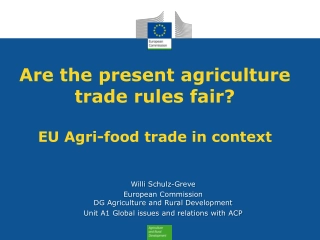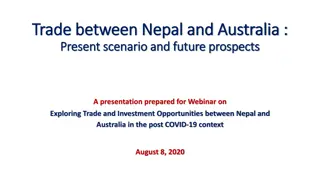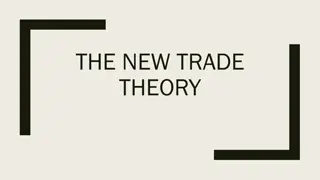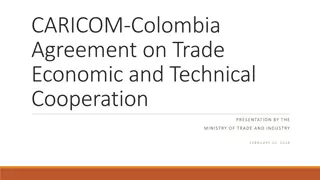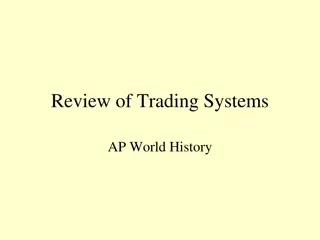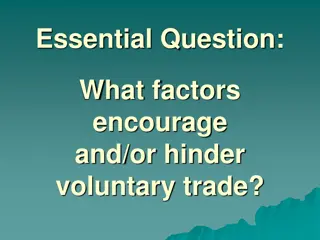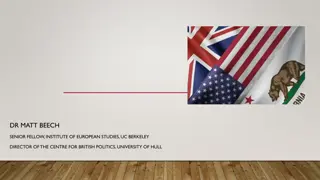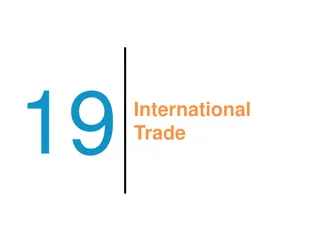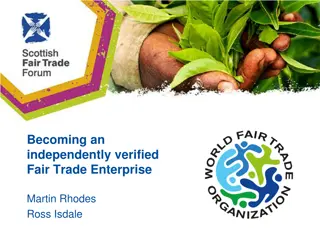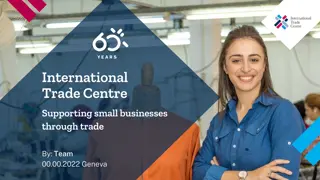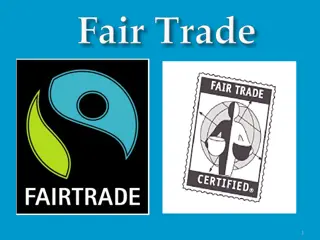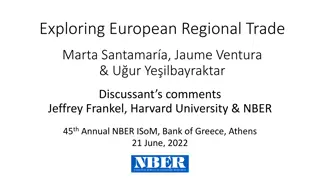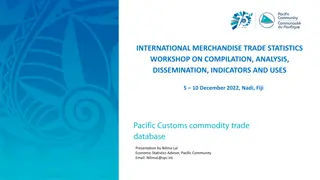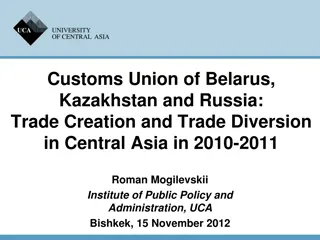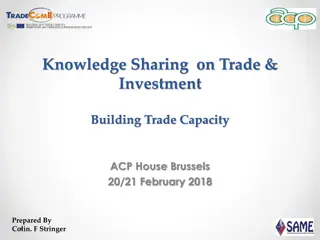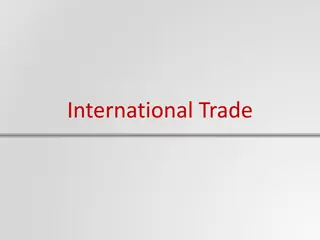Fair Trade Structure and Impact
Fair Trade involves buyers in the U.S. paying a premium for products exported by developing nations, such as coffee and handicrafts. This practice helps to bypass middlemen, ensuring more returns for growers and producers. The economics of coffee production reveal how growers in the informal sector can benefit from increased prices. Understanding the basics of how Fair Trade works sheds light on the importance of certification and consumer willingness to pay a premium.
Download Presentation

Please find below an Image/Link to download the presentation.
The content on the website is provided AS IS for your information and personal use only. It may not be sold, licensed, or shared on other websites without obtaining consent from the author.If you encounter any issues during the download, it is possible that the publisher has removed the file from their server.
You are allowed to download the files provided on this website for personal or commercial use, subject to the condition that they are used lawfully. All files are the property of their respective owners.
The content on the website is provided AS IS for your information and personal use only. It may not be sold, licensed, or shared on other websites without obtaining consent from the author.
E N D
Presentation Transcript
Fair Trade Structure and Impact
How Fair Trade Works Buyers in U.S. agree to pay a premium for products exported by developing nations Originally only commodities notably coffee As movement developed, handicrafts became major part of Fair Trade Some type of organization an NGO or a Fair Trade organization develops contacts with growers or producers in developing nation Arrange to have good shipped outside normal trade channels Avoids middlemen from taking most of the returns to the product
Economics of Coffee Consumer pays $6 or $7 per pound for a good Arabica coffee Mark up at grocery store could be 1/3 to of that Distributor also might take 1/3 for shipping and local distribution Advertising, other costs are also added Grower is left with (in the past) about $1/pound on a $6 or $7 sale Much of the coffee sold in lesser developed countries is sold through coyotes Buyers who deal directly with growers who have no way of contacting purchasers who might pay more
Note that much of Coffee Production Occurs in Informal Sector Family produces food and shelter for themselves; grows coffee on the side to provide some increase in their standard of living Incremental income might pay for schooling, which is not free in most developing nations MAJOR change in standard of living if the price of coffee can be increased Increase in income at the margin can be a major benefit Also note that if a mechanism is found to raise coffee prices, corporations will take advantage of that Impossible to confine the benefits just to those in the informal sector
Basics of how Fair Trade Works Workers form a coop and agree to conform to a number of conditions to be part of Fair Trade Much more on that later A Fair Trade organization operating in the developed world- purchases goods at a premium Markets them in the U.S. and Europe under a Fair Trade name Brings up issue of certification how does one know a product is actually Fair Trade labeling becomes very important Major issue -> Fair Trade goods are more expensive how to get consumers to pay a premium?
Education of Consumer Critical in Fair Trade If Folgers is $6 per pound and FT coffee is $8 per pound, why should someone buy it? Embedded Philanthropy purchase is philanthropic (not charity) because it contains both the good itself and a benefit to those less well off Equivalent to Girl Scout cookies or the buy a unit of good x, and $1 will go to charity Notably, FT sellers also try to hand other ornaments on the goods Coffee is organic, sustainable, Non-GMO . This mixing up of the message may be counter-productive, as commercial products use similar messages Issue remains .how to get consumers to buy?
Sell in Places where Education about FT Possible Notably higher education Fairfield has had a variety of FT initiatives on campus over the years Chocolate was one of the easiest Also had sales of FT handicrafts take place in Barone Campus Center Education of a potential buyer takes place at point of sale Most common place for sale was a church or synagogue Ability to provide INTENSE education of potential consumers Churches also used this as a fundraiser Sales in traditional grocery stores were problematic Impossible to educate consumer unless someone placed in the coffee aisle at your local grocery store
Organizations that Engage in Fair Trade Two different approaches Equal Exchange (Massachusetts) Products sold wholesale to churches, schools and universities Then sold to consumers Mostly commodities coffee, cocoa, chocolate, tea, spices, etc. Second approach -> Direct storefront Ten Thousand Villages Set up mostly in university/college towns Offers mostly crafts, commodities are a sideline Still offers opportunity to educate consumer about what they are buying
Product List No limit to what has been marketed as Fair Trade Traditional goods: Coffee, chocolate, tea FT organizations add in dried fruits, pasta, sauces, spices, etc. Key problem is generating sufficient demand for a product group to justify cost of setting up a coop to produce the product FT clothing is also a thing, as is FT wine Becomes part of habits of ethical consumer Start day with FT coffee and a FT cereal, dress in a FT shirt, drive to work in a Prius and come home to dinner made using FT sauces served over FT pasta Some have argued that it will get to be too much for many individuals -> worrying all day about what products they consume .
Certification -> A Growing Problem Challenge to movement -> businesses have tried to co-opt the FT label to increase demand for their products Nestle briefly tried marketing Fair Trade chocolate until they were called out on it (company itself was setting the standards) Fair Trade KitKat Products labeled Fair Trade are offered at Trader Joes and Aldi But who is behind certification? If self-certified, label may mean nothing Most rigorous standards are imposed by FLO Fair Trade Labeling organization
FLO is Oldest Certification Body Present since the beginnings of Fair Trade Comprehensive list of criteria growers must meet to label their products with the FLO symbol Multi-year process in which growers are expected to meet tighter and tighter standards to remain Fair Trade Explains why some coops fail
Timeline of FT Certification under FLO Timeline of FT Certification under FLO First, Coop forms and expresses consent (by vote of growers) to apply for FT certification 1styear is relatively simple -> Ensure that growers comply with FT model and ensure that no non-FT products end up mixing with output Farmers who are not part of coop must be excluded 2ndyear -> Farmers must be made cognizant of restrictions on pesticide use and water conservation Note that this is an added expense, and some farmers will balk at the outlays if the FT price is not significantly above the market price
By Year 3. Governing council formed to act on behalf of coop Consideration of Global Climate Change effects of growing products must be taken into account Seems like a lot to ask of subsistence grower in a developing nation By years 5 and 6, the coop can become fully certified if it has managed to take all these steps Not surprising that some don t succeed Gold Standard of certification
Competing Certification Body Fair Trade USA Standards are less onerous Certification can be obtained quickly and without conforming to as many steps Since consumers are poorly informed about FT products to begin with, to some growers this is the preferred path Far fewer details on website about process, but it is simpler
Existence of 2 paths to certification has set off kind of a war between the two organizations FLO claiming it is the real certification body Fair Trade USA responding that it is facilitating more rapid growth of the movement and better access Likely this will be an ongoing conflict Consumers don t want to be part of this battle just want information Once again, this is where education of the consumer through churches, synagogues, etc. is important
Fair Trade Article Fair Trade Article Fighting the Tide Fighting the Tide Most important points of the article Like most subsidization schemes, paying an increased return on a product is inferior to a cash grant If growers are balancing purchasing a bundle of goods, X, but also enjoying leisure in the amount L Changing the price of leisure (the wage rate) will change the relative utility of leisure v. other goods The level of utility obtained will be lower for the same amount of funds injected On the positive side, FT promotes work and a learning process for workers that may be beneficial in the future
Advantages and Disadvantages Advantages and Disadvantages Obvious advantage is the rise in income for growers/producers in the developing world Other major advantage is the passing on of expertise regarding marketing, what type of goods to offer, etc. Two major disadvantages Provides incentive for producers to remain in markets that are not good long-term prospects Coffee production is too high FT helps maintain that Creates a schism between those in and those out of the system A FT grower might end up with innovations that place other coffee producers at a disadvantage
Evaluation and Critique of Commodity Evaluation and Critique of Commodity Stabilization Stabilization Incongruity of running 3 programs parallel to one another at same time If any were working, why do the other two? Also, odd that the EEC/EC/EU running a subsidy program at same time caretls are attempting to force prices higher Helpful to put three programs side-by-side
Comparisons of Purpose, Mechanisms, Prices, etc. Characteristics/Pricing Scheme Cartels Fair Trade Stabex Target 7 Major Commodities 2 Commodities + Many Noncommodities Wide range (50) of Extractive Goods Structure Institutional UNCTAD and Commodity Associations Informal -> Some Degree of Organization through FLO Institutional EEC/EC/EU Anti-Market Market-Based Embedded Philanthropy Neither Mechanisms Buffer Stocks, Export Controls Alternative Distribution Channel Convincing Consumers to Pay More Direct Subsidies based upon Deviation of Price from Target Price Inherent Obstacles Price Subsidies Promote Over-Production, Cheating Consumer Awareness low and Difficult to Raise Funding Inadequate. Developing Nations Viewed Loans as Grants Price Stabilization Increased Price when Inclusive of Subsidies
Path Forward. Path Forward . Alternative strategies for developing nations: Eschew the GATT/WTO system at least further tariff cutting and pursue workable regional integration Potentially linking existing FTA s into bigger associations No reason why Mercosur, Andean Group and Caricom could not form a VERY large regional trading group Within that group, reorientation of trade specialization could be a focus Reduce the number of exporters to a manageable number within each product group Conduct joint development policy -> something ASEAN sought to do Develop industries that have both economies of scale and some freedom from competition
Trade Patterns in the Trade Patterns in the Devloping Devloping World World Working against diversification Climate -> Many developing nations have limited agricultural land Rain forest or desert may dominate Pre-cursor to development (and trade) is establishing an agricultural surplus If farmers can produce enough to feed themselves and others, some are freed from subsistence agriculture Permits part of the population to engage in production for export Whether it be agricultural goods or manufactures If land is mostly rain forest, that will determine production (coffee, cocoa, natural rubber, etc.) may stymie efforts to diversify
As Diversification Advances Economic cooperation more difficult key products become less important negotiations on production produce fewer results Figures below on cocoa show why a cocoa cartel was able to reform One of the few products where several nations have still failed to fully diversify Again, climate working against moving into new products As noted earlier in course, even moving farther along production chain made difficult by tariff policies of developed world Cocoa is tariff-free, chocolate is tariffed
Patterns of Trade of Commodity Dependent Patterns of Trade of Commodity Dependent Countries Countries Some (formerly) dependent coffee exporters Colombia: Petroleum, coal, coffee, gold, refined petroleum Total exports = $40.5 Billion Coffee exports = $3.2 Billion (7.9%) Guatemala: Coffee/tea, clothing, fruits, nuts Total Exports = $13.6 Billion Coffee Exports = $928 Million (6.8%) Cote D Ivoire: Cocoa, Natural rubber, gem stones Total Exports = $12.9 Billion Coffee Exports = Negligible
Continued Formerly dependent cocoa producers Ghana: Oil, gold, cocoa beans Total Exports = $12.8 Billion Cocoa Exports = $2.8 Billion (21.9%) Cameroon: Mineral fuels, cocoa, wood Total Exports = $5.2 Billion Cocoa Exports = $805 Million (15.5%) Cote D Ivoire: Cocoa, rubber, gold Total Exports = $12.4 Billion Cocoa Exports = $3.8 Billion (30.6%)
Continued Sugar producers Brazil: Iron ore, soybeans, petroleum, crude sugar Total Exports = $247 Billion Sugar Exports = $10 Billion (4.0%) Cuba: Tobacco products, nickel, sugar Total Exports = $1.72 Billion Sugar Exports = $173 Million (10.0%) Ecuador: Mineral fuels, fish, fruits/nuts Total Exports = $25.3 Billion Sugar Exports = Negligible
Finally, One Mineral Product (Tin) Finally, One Mineral Product (Tin) Peru: Copper, gold, refined copper Total Exports: $56.3 Billion Tin Exports: $860 Million (1.5%) Bolivia: Gold, petroleum gases, zinc Total Exports: $11.0 Billion Tin Exports: $507 million (4.6%) Malaysia: Electrical Machinery, mineral fuels, computers Total Exports: $352 Billion Tin Exports: Negligible
In General, Outside of Cocoa, Diversification has been Achieved Countries no longer focused on the prospects for individual commodities Organizations that promote these products are still around International Cocoa Organization (ICCO) International Coffee Organization (ICO) Natural Rubber Association (NRA) Promote continued growth of consumption in industrialized countries Except for the reformation of the cocoa cartel, do not pursue production and price agreements UNCTAD s advice to developing nations is to use forward markets to reduce risk
On the Negative Side.. Diversification out of commodity production has not been achieved Note the primary products being export Most are still commodities Mix blunts effects of price changes -> For Colombia, coffee prices and petroleum prices are unlikely to move in tandem (graph) Downward trend in one commodity presumably offset somewhat by different price trend in other commodity The more goods added to the mix, the greater the protection
Forward Markets Forward Markets When the cartel movement collapsed, UNCTAD began recommending forward (futures) markets as a substitution Forward markets originally developed to protect farmers in the U.S. from a market imperfection ALL corn farmers harvested at about the same time -> buyers (commercial) would delay making purchases until a degree of desperation set in (corn was beginning to decay) Then offer prices that were well below market Market imperfection made farming far less profitable
How Forward Markets Work How Forward Markets Work Chicago Mercantile Exchange is oldest Offers a wide variety of options on commodities, currencies, even crypto Cattle, soybean, corn, petroleum, silver, gold, palladium, etc. Even treasury notes https://www.cmegroup.com/ In general, contracts offered for 30- 60- 90- and 120- periods There must be an institution behind the any futures contract Exposure is enormous if prices move too much
Contracts Bought and Sold on Margin Contracts Bought and Sold on Margin Purchasing a 30-day corn contract for July delivery for 10,000 bushels @ $10 per bushel ($100,000 total) might require on 5% down Encourages gambling -> alters purpose of market to a degree, but farmers still use system to eliminate risk In above, only invested $5,000 -> if price goes down marginally (5%) investment is gone If bought as an option, $5.000 is gone Conversely, if price goes up 5%, you will break even ($5,000 return - $5,000 option fee =net zero) If price goes up 10%, will net $10,000 doubling your money
For Commodity Producers (Real Purpose) For Commodity Producers (Real Purpose) Can pre-sell output at a known price Plant soybeans in May, agree to sell in August (a put ) Agreement to buy is a call Food producers that use soybeans will agree to buy, eliminating risk that price will go up Note that, it is just as likely you will lose engaging in one of these contracts For farmer, price goes up beyond futures contract price Would have done better not using an option But, certainly is eliminated, so planning can occur If price rises enough, farmers will simply allow the option to expire
New York Mercantile Exchange is where Commodities from Developing World are Traded Sugar, cocoa, coffee https://quotes.ino.com/exchanges/category.html?c=food Developing nation can pre-sell its output (using an option, to avoid weather risks) Know definitively what price will prevail, and plant accordingly If prices rise significantly above options price Allow option to expire and sell in spot market Likewise, sugar, cocoa and coffee users (e.g. Hershey) can lock in a known price
Problem is one of Time. Problem is one of Time . Length of lock-in of prices is, at best, 180 days Planning horizon for many of the commodities sold by developing nation is years Cocoa trees take 4-5 years to produce, longer for coffee trees Developing nations cannot react to price changes by changing production Output is pre-determined If prices are weak, only solution would be to withdraw production from market Not a great option
For Mineral For Mineral Commodites Commodites Can easily adjust output to market conditions Tin, for instance Use 6-month forward contract to establish price of tin year out Produce accordingly Does not solve problem of long-term declining prospects for commodities Should also note that consumers of commodities use options market in same way Hershey s pre-buys its cocoa Can then plan on costs and profit maximize
Remaining Issue. Even if one nation reduces its output in response to falling prices, others may not Problem that plagued OPEC for most of its existence Prices would weaken, and Saudi Arabia would encourage production cuts Most nations ignored the Saudis, leaving them the only country self- imposing the cuts Saudis finally punished all of OPEC in 1986 through massive over- production that led to deep price cuts So, only if several nations cut output will this work as a control
Active Diversification Strategies.. Active Diversification Strategies .. No perfect solution to commodity problem Increased cooperation through regional integration has been suggested 1960s, Central American Common Market (CACM) Failed due to regional conflict (Nicaraguan conflict) But, if pushed through, nations could have cooperated on production Instead of all nations producing coffee, some would have specialized in other tropical crops (e.g. bananas) Would have reduced production to a degree
For Mercosur. Brazil is an industrialized economy, while Paraguay and Uruguay are still mostly agricultural Argentina remains a global source of high-end beef As long as production by one country is not cannibalized by its partners, all win ASEAN, from its inception, pursued region-wide industrial policy Not regarded as particularly successful, but laid the framework for using coordinated policy across nations to prevent multiple competing producers
Former use of Policies such as ISI Former use of Policies such as ISI Import-substituting industrialization Process of industrializing based upon creeping up the production chain Tariff protection an essential part of ISI Example -> automobile industry Set up assembly plant and import components for assembly (Japanese did this to avoid U.S. VER in 1980s) Impose high tariff barrier, so if company wants to sell in nation, it must abide by requirement that PARTS imports are encouraged, but not finished product After a period of time, begin making basic components of car domestically and, once again, discourage imports of competing products
Continued.. Finally, begin production of entire product -> once again, tariff protected When fully established, tariffs can be reduced Although can be applied to individual nations, in regions like Central America, might be consortium of nations ISI was applied in Brazil and elsewhere Although technically, nothing wrong with technique, result was very, very high cost industries No competition, so no incentive to develop efficient production In practice, final step above (reduction of tariffs) never happened Cars built behind a wall of high tariffs were high cost Removal of tariffs would have decimated an industry that took years to build up
ISI Usually viewed as Anti-Free Trade Counter argument is that comparative advantage might be unobservable until a nation has achieved economies of scale Perhaps, based upon resources, available labor, transportation system, Argentina is the best place to produce cars in the world A small automobile plant will, regardless of the efficiencies of the market, be unable to compete with the large-scale plants elsewhere in the world ISI would enable an industry to grow until it is of sufficient scale to compete globally Unfortunately, ISI applied mostly as a political tool Little regard for actual attainment of efficiencies Particularly when governments swung left
Most Nations in Latin America Tried ISI First in consumer non-durables -> food and beverages, for instance Then into automobiles, machinery, electronics Boldest jump was into commercial aircraft production Embrier of Brazil makes short-hall aircraft competes to a degree with Boeing 737, although smaller As a reflection of the cost problem that inevitably arises Tariff on electrical transformers exported to Brazil was a high as 400% at one time Obviously, this produces high costs in the economy for businesses that use transformers
Finally, Path Pursued by Asian Tigers Export promotion strategy Thailand, Indonesia, Malaysia, the Philippines Made jump to consumer electronics from extractive products Led to years of extra-normal growth, unique in the Pacific Rim What does the trade of the 4 Asian Tigers look like Thailand: 1.Electrical machinery, equipment: US$45.3 billion (16% of total exports) 2.Machinery including computers: $43.9 billion (15.5%) 3.Vehicles: $31.3 billion (11%) 4.Rubber, rubber articles: $18.8 billion (6.6%) 5.Plastics, plastic articles: $15.1 billion (5.3%) 6.Gems, precious metals: $14.8 billion (5.2%)
Malaysia 1.Electrical machinery, equipment: US$127.9 billion (36.3% of total exports) 2.Mineral fuels including oil: $60.2 billion (17.1%) 3.Machinery including computers: $27.5 billion (7.8%) 4.Animal/vegetable fats, oils, waxes: $23.7 billion (6.7%) 5.Optical, technical, medical apparatus: $14.4 billion (4.1%)
Summary Table Means of Reducing Trade Vulnerability/ Impacts Diversification Options Markets Import Substituting Industrialization Export-Driven Growth (Asian Tigers) Goals More stable (overall) export prices Short-term certainty on pricing Elimination of import dependence Export of high value-added goods Export Price Variability Reduced (graph) Price certainty short-term NA Lower Manufactured good pricing more stable Import Dependence NA NA Lower Lower Sustainability/ Impact of Competition Partial solution NA Side effect of ISI Multiple new entrants would weaken model Efficiency NA Yes Fail Yes Vulnerability to trade protections No NA Sort of Yes
The Death of Globalization and its Impact on Trade Goals of globalization Bring developing nations fully into global trading system Enable the partial industrialization of developing nations, particularly China, India, Brazil (supposedly Russia and South Africa) Raise standards of living Weaken the dominance of European nations, the U.S. and Japan in global trade Increase global governance through expansion of international bodies (e.g. the EU)
Why System is Partially Unraveling.. Why System is Partially Unraveling .. Accomplishments seem under-whelming and costs too high Accomplishments: Integrating China into the WTO and world trading system Increasing India s role in global trade Successfully integrating some nations (e.g. Asian Tigers) into global trade in manufacturing Huge drop in trade barriers, although mostly happened by 1977 GATT round A seeming reduction in regional conflict -> Ukraine being the major exception Closer trade ties reduce incentive for conflict
Factors Leading to Rejection of Aspects of Globalization Some basic assumptions in error Assumed (for U.S.) that even if production went overseas, design, sales and service would provide sufficient jobs Reality: Employment not only an issue, but wages are substantially lower in service economy (car salesman does not make what an assembler does) Developing nations would be lifted out of commodity dependence Numbers we have reviewed showed this did not happen -> traded one set of commodities for another Diversification has helped economically, but many are expressing frustration that little industrialization for export has occurred
